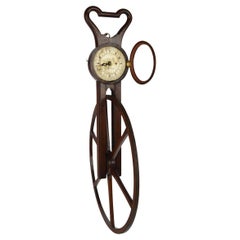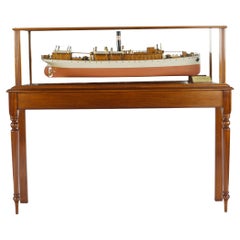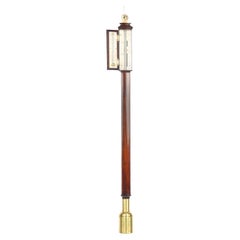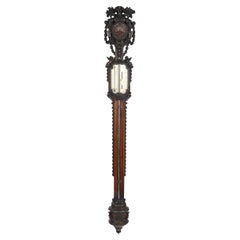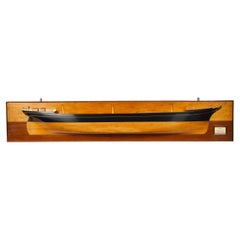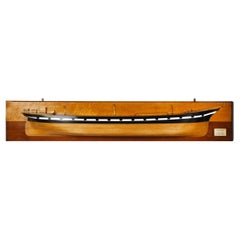WICK ANTIQUES LTD Collectibles and Curiosities
to
135
133
2
4
3
3
10
94
29
2
18
8
1
6
5
3
4
3
1
1
74
60
22
20
15
129
119
105
9
3
135
135
135
2
1
1
1
1
A fine late Georgian mahogany waywiser by Alfred Joy, Chichester
Located in Lymington, Hampshire
A fine late Georgian mahogany waywiser by Alfred Joy, Chichester, comprising a revolving wheel connected to a recording dial marked in yards and poles on one scale and in furlongs an...
Category
Antique Early 19th Century English Georgian Scientific Instruments
Materials
Mahogany
A mirror-backed shipyard model of ‘S.S. Scott’, by Garston of Liverpool, 1904
Located in Lymington, Hampshire
A mirror-backed shipyard model of ‘S.S. Scott’, by Garston of Liverpool, 1904, the half-hull model of this steam cargo ship showing a black funnel with an orange and white stripe, pa...
Category
Early 20th Century English Nautical Objects
Materials
Brass
A fine mahogany ship’s stick barometer by Dolland & Son
By Dolland
Located in Lymington, Hampshire
A fine mahogany ship’s stick barometer by Dolland & Son, of typical slender form with brass fittings, the plate engraved ‘Very dry, Set Fair, Fair, Rain, Stormy, Dolland London’. En...
Category
Antique Early 19th Century English Scientific Instruments
Materials
Brass
Lord Vernon’s Sudbury Hall lime wood barometer, by J. Braund after Grinling Gibb
By John Braund
Located in Lymington, Hampshire
Lord Vernon’s Sudbury Hall lime wood barometer, by J. Braund after Grinling Gibbons, of typical form within a case richly carved with high relief strapwork comprising bellflowers, fo...
Category
Antique 19th Century English Scientific Instruments
Materials
Wood
A half hull model of iron barque “Java” 1881
Located in Lymington, Hampshire
A half hull model of iron barque “Java,” 1881, on a bird’s-eye maple and mahogany backboard with 3 truncated masts, black topsides and a plaque stating ‘Java, Russell & Co. Ship Buil...
Category
Antique Late 19th Century Scottish Nautical Objects
Materials
Birdseye Maple, Mahogany
A half hull model of ‘Sutherlandshire’ by Russell & Co, 1882
Located in Lymington, Hampshire
A half hull model of ‘Sutherlandshire’ by Russell & Co, 1882, set on a bird’s eye maple and mahogany a backboard with 3 truncated masts, white painted panels on the black topsides an...
Category
Antique 19th Century Scottish Nautical Objects
Materials
Birdseye Maple, Mahogany
Original Gelatine Print of a Gentleman’s Steam Yacht
Located in Lymington, Hampshire
An original gelatine print of a gentleman’s steam yacht steaming eastwards through the Solent by Wm U Kirk. Impressed to the right hand side.
Circa 1900
Category
Antique Early 1900s English Nautical Objects
Materials
Paper
A historically important Victorian silver tea and coffee set
Located in Lymington, Hampshire
A historically important Victorian silver tea and coffee set, presented to Francis Pettit-Smith, inventor of the screw propellor, in 1856, comprising a coffee pot, a tea pot, a cream...
Category
Antique 19th Century English Victorian Historical Memorabilia
Materials
Silver
A Fine Cased Presentation Builder’s Model of the S. S. Tamaqua Cargo Ship
Located in Lymington, Hampshire
The model of particularly large scale and fine quality, contained within an oak glazds case on contemporary bespoke stand. The model worked in intricate detail and incorporating bras...
Category
Early 20th Century English Nautical Objects
Materials
Brass
A Very Fine and Historically Significant George III Silver Mounted Powder Horn
Located in Lymington, Hampshire
This fine powder horn has silver mounts by the silversmiths Thomas Phipps and Edward Robinson, hallmarked for London, 1803. The charger on the horn has three adjustments and a side lever system and the wider end of the horn has a silver cap engraved with two crests, shields and family mottoes. The crests are for the Maitland and Dick families and represent the lineage of Rear-Admiral Sir Frederick Lewis Maitland. The Maitland line, represented by the lion crest and the motto Consilio et Animus represents the arms of the male line. Maitland’s father, also Frederick Lewis Maitland (1730-1786), had an interesting and successful naval career though was rather overshadowed by the later successes of his son. The martlet (small bird) crest and motto In Domino Confido is the female line, in this case Margaret Dick, daughter of Viscount Frendraught. The Dick family was important in the clan hierarchy in Scotland, being the head of Clan Crichton and heir to Clan Makgill at this time.
Provenance
Rear-Admiral Sir Frederick Lewis Maitland KCB (1777-1839) and thence by descent
Rear-Admiral Sir Frederick Lewis Maitland KCB (1777-1839)
Born in Fife, Maitland was the father of a distinguished naval officer as discussed above. Mailtand joined the navy straight from school and, whilst serving on the frigate HMS Southampton under captain Robert Forbes...
Category
Antique Early 19th Century English George III Nautical Objects
Materials
Silver
A Fine Presentation Half Hull Model of the Hawthornbank, launched in 1889
Located in Lymington, Hampshire
A Fine Presentation Half Hull Model of the Hawthornbank, launched in 1889 and Built by Russell and Co of Greenock and Glasgow for Andrew Weir of Glasgow
A fine and important half h...
Category
Antique 19th Century English Nautical Objects
Materials
Brass
Large and Imposing Regency Nautical Chair Made for the Alliance Assurance Comp
Located in Lymington, Hampshire
A large and imposing Regency nautical chair made for the Alliance assurance company, the rectangular leather covered back, padded arms and seat surmoun...
Category
Antique 1820s English Regency Armchairs
Materials
Leather, Wood
Royal Southampton Yacht Club Cannon
Located in Lymington, Hampshire
This pair of early Victorian three-stage bronze signal cannon are set on elm carriages with bronze fittings.
Each 39 inch tapering barrel has one reduction and a ball cascabel. Th...
Category
Antique 1840s English Historical Memorabilia
Materials
Bronze
The UBS America’s Cup Jubilee Race solid silver trophy by Theo Fennell, 2001
Located in Lymington, Hampshire
The UBS America’s Cup Jubilee Race solid silver trophy by Theo Fennell, 2001. This striking trophy is of conical form, featuring three spinnakers on a downwind course, set on a circu...
Category
Early 2000s English Nautical Objects
Materials
Silver
A Victorian wool picture of a three masted frigate flying several flags and ensi
Located in Lymington, Hampshire
A Victorian wool picture of a three masted frigate flying several flags and ensigns, within a border of red, blue and white trellis, in the original frame, regilded. English, circa ...
Category
Antique Mid-19th Century English Nautical Objects
Materials
Wool
A Napoleonic era bone prisoner of war model of the 40-gun frigate ‘Creolian’
Located in Lymington, Hampshire
A Napoleonic era bone prisoner of war model of the 40-gun frigate ‘Creolian’, the three masted barque with a planked hull, finely detailed with a carved poop deck and a female figurehead, intricate black thread rigging and a black plaque stating in gilt, Creolian. In the original glazed wooden case with a painted background of a sunset over a bay with ships on the horizon. French, circa 1800.
Provenance Ivan Roll Amis, d. 1 July 1970
Richard Henry Allen Amis, CBE, thence by descent
During the Revolutionary and Napoleonic Wars (1793-1815), large numbers of French soldiers and marines were taken prisoner. To help pass the time and generate a small income, they would make a variety of objects—including ship models—from simple, easily-sourced materials such as bone and wood for sale at local markets. Typically, the models were not made to scale and tools were limited, making the quality and attention to detail in this work even more remarkable. To realise a good price at market, the models were often named after famous ships of the time. It may well be that this ship was the ‘Créole’, a 40-gun frigate of the French Navy. She served in the Brest squadron, took part in Ganteaume’s expeditions of 1801 to Egypt, and was involved in the French acquisition of Santo Domingo (also known as the Era de Francia) and briefly detained Toussaint Louverture...
Category
Antique 19th Century French Nautical Objects
Materials
Bone, Wood
A shipyard model of the survey and site investigation ship M.V. Whitehorn
Located in Lymington, Hampshire
A shipyard model of the survey and site investigation ship M.V. Whitehorn, with a red hull, green waterline and grey topsides, the funnel painted blue and white with the letter ‘C’, ...
Category
20th Century English Nautical Objects
Materials
Wood
A Fascinating Ship’s Log And Journal Relating To The Whitway/Whiteway
Located in Lymington, Hampshire
A Fascinating Ship’s Log And Journal Relating To The Whitway/Whiteway Family of Bristol Mariners, Along With A Dispatch Letter From The Bureau in St Petersburg Relating to One Of The...
Category
Antique Early 19th Century Nautical Objects
Materials
Paper
A Victorian shipyard model of a sloop
Located in Lymington, Hampshire
A Victorian shipyard model of a sloop. This large boxwood model has a truncated mast and retractable bowsprit. The hull has an upright stem, wide beam, four metal rigging blocks on e...
Category
Antique 19th Century English Nautical Objects
Materials
Boxwood
Sir Harold Dudley Clayton: Naval architect and boat builder’s plans for Zinita
Located in Lymington, Hampshire
Sir Harold Dudley Clayton: Naval architect and boat builder’s plans for Zinita, 1909. Four framed naval architect’s drawings of the sail plan, cabin plan, sections and hull of ‘Zinit...
Category
Early 20th Century English Nautical Objects
Materials
Paper
A cased shipyard model of S.S. Burbridge/S.S. Burcombe, 1912
Located in Lymington, Hampshire
A cased shipyard model of S.S. Burbridge/S.S. Burcombe, 1912. This single model depicts two sister ships. It has black painted topsides, pink hull and dark grey decks. There is a bla...
Category
Early 20th Century English Nautical Objects
Materials
Brass
Sir Harold Dudley Clayton’s scale model of Coquette, 1899
Located in Lymington, Hampshire
Sir Harold Dudley Clayton’s scale model of Coquette, 1899. This large model is of the 1/12th scale 10-ton Bristol Channel One Design class Coquette: She is fully rigged with furled s...
Category
Antique 19th Century English Nautical Objects
Materials
Wood
Captain Thomas Stuart’s Medals for Gallant Service 1793-1840
Located in Lymington, Hampshire
Captain Thomas Stuart’s Medals for Gallant Service 1793-1840 This very fine group of four medals was awarded to Captain T. Stuart, Royal Navy, who was recognised for his part in the ...
Category
Antique Mid-19th Century English Nautical Objects
Materials
Brass
An unusual mirror-backed model of a section of the steamship Catherine Govan
Located in Lymington, Hampshire
An unusual mirror-backed model of a section of the steamship Catherine Govan, of rectangular form, showing three decks of lined boxwood decking, a carved wooden lifeboat in silvered ...
Category
Antique Late 19th Century English Nautical Objects
Materials
Boxwood
A ship’s ‘Sunday’ tiller carved with Princess Victoria, before she was Queen
Located in Lymington, Hampshire
A large ship’s ‘Sunday’ tiller carved with Princess Victoria, before she was Queen. This long yacht tiller is made from a single, solid piece of mahogany and has a typical shallow S-...
Category
Antique 19th Century English Nautical Objects
Materials
Mahogany
Captain Thomas Green’s silver Medals for Heroic Conduct at Sea
Located in Lymington, Hampshire
One medal from Captain Logan of the Mars is inscribed ‘Presented by Captn. John Logan, of the Ship Mars that was Wrecked in a gale on the Gunfleet Sands, Jany...
Category
Antique 19th Century English Nautical Objects
Materials
Silver
A shipyard model of the liner Nippon Moru, dated 1898
Located in Lymington, Hampshire
A shipyard model of the liner Nippon Moru, dated 1898. This shipbuilder’s model has a pink hull, black topsides and two black funnels. It is executed in meticulous detail with two c...
Category
Antique Late 19th Century English Nautical Objects
Materials
Brass
A brass ship’s bell from Peninsular & Orient liner S.S. Ballarat
Located in Lymington, Hampshire
This bronze ship’s bell is incised with the legend ‘Ballarat’ and has a suspension bracket and plaited rope bell-pull. The interior is painted white....
Category
Antique Late 19th Century English Nautical Objects
Materials
Brass
A gaff-rigged Hastings lugger circa 1880
Located in Lymington, Hampshire
This scale model of a Hastings lugger is very similar to the one described in E.W. White’s book as typical of this type of fishing vessel. She has an extremely wide beam, centreboard...
Category
Antique Late 19th Century English Nautical Objects
Materials
Glass
Sir Harold Dudley Clayton’s Hydraulic Steam Lifeboat: City of Glasgow, 1894
Located in Lymington, Hampshire
Sir Harold Dudley Clayton’s Hydraulic Steam Lifeboat: City of Glasgow, 1894. This fine builder’s presentation scale model has a gilt brass funnel, polished brass rudder, capstan, anchor, binnacle and fittings with side grab ropes. The hull is painted in RNLI blue and red, with a pink keel. It is raised on a turned brass support within an ebonised glazed case on a stand and has a presentation plaque inscribed ‘Hydraulic Steam Lifeboat City of Glasgow’ Built For the Royal National Lifeboat Institution, by R & H Green, Blackwall Yard, London, 1894′.
Provenance: Sir Harold Dudley Clayton. The following pages are dedicated to the substantial and fascinating archive of Sir Harold Dudley Clayton. This includes the lifeboat model above, over 100 yacht designs and naval architects’ drawings, photograph albums, photographic glass slides and a model of his yacht Coquette.
Steam-powered lifeboats. Earlier in the 19th century steam had transformed Britain’s industrial landscape through the development of steamships and the railways. But tending a coal-fired boiler in a boat that is pitching and rolling in heavy seas would not have been straightforward. Sixty years after the idea was first mooted by Sir William Hillary and after extensive trials, the first steam-cum-sail boat Duke of Northumberland went into service at Harwich Lifeboat Station in September 1890. The hydraulic steam-driven lifeboat used...
Category
Antique 19th Century English Nautical Objects
Materials
Brass
The large and interesting silver gilt trophy of Captain George
Located in Lymington, Hampshire
The large and interesting silver gilt trophy of Captain George Welstead, purchased with prize money from the East India Company, 1805, in the form of a footed cup with a separate cov...
Category
Antique 18th Century English Nautical Objects
Materials
Silver
A Pair of Davenport Admiral Lord Nelson Terracotta Wine Coolers
Located in Lymington, Hampshire
A Pair of Davenport Admiral Lord Nelson Terracotta Wine Coolers, each relief moulded with a portrait of Admiral Viscount Nelson, in full uniform and medals, between two acorn-bearing oak boughs on one side and a naval panoply on the reverse. The rim comprises tied reeds with twin dolphin-mask handles attached to the sides. English, circa 1815.
Two very similar examples from the collection of Horatio, third Lord Nelson, are illustrated in an article titled ‘Nelson Relics and Relic Hunters’ in The Windsor Magazine, Vol. XX. June-November 1904, p.519. (See also page 4.) A thirdwith a paper label stating ‘Exceedingly rare (Lockett)’ was exhibited at the Hanley Museum, item No.1721 (see Britain on the High Seas, from Nelson to Churchill, p.71, Wick Antiques...
Category
Antique Early 19th Century English Nautical Objects
Materials
Terracotta
A plaster military trophy panel from the Duke of Gordon’s house in Edinburgh
Located in Lymington, Hampshire
A plaster military trophy panel from the Duke of Gordon’s house in Edinburgh, the panel carved with a panoply including a shield, quiver, wrapped standard and sword, all within an oa...
Category
Antique Late 19th Century Scottish Historical Memorabilia
Materials
Plaster, Oak
Victorian Half Hull Model of a 3 Masted English Schooner
Located in Lymington, Hampshire
A Victorian half hull model of a 3 masted English schooner, shown facing left, the shaped soft wood hull with black painted top sides and applied wood toe rail and gunwales, the bow ...
Category
Antique 1870s English Nautical Objects
Materials
Wood
Midshipman Proctor’s Sword for Valour at the Battle of Copenhagen
Located in Lymington, Hampshire
This curved sword has a blued steel German blade with an ivory cross-hatched grip bearing silver and gilt mounts in the form of a lion’s head and mane. ...
Category
Antique Early 1800s English Arms, Armor and Weapons
Materials
Silver, Steel
Rare Scrimshaw Decorated Horn
Located in Lymington, Hampshire
A rare scrimshaw decorated horn, engraved over one side with the Royal Arms countersigned and titled ship profiles for the Great Eastern, the Great Britain,...
Category
Antique 1860s English Nautical Objects
Materials
Horn
Admiral Viscount Nelson and Lady Emma Hamilton in the Studio of George Romney
Located in Lymington, Hampshire
This oil painting shows the fictional scene of Emma, Lady Hamilton meeting Lord Nelson in Romney’s studio. She is seated for her portrait wearing a full pink skirt under a tightly f...
Category
Antique 1880s English Paintings
Materials
Paint
A sailor’s carved coconut Bugbear powder flask
Located in Lymington, Hampshire
A sailor’s carved coconut Bugbear powder flask. This carved coconut is carved with two ovals, one showing a military panoply with standards, bayonets, swords and bugles all above a ...
Category
Antique Early 19th Century English Arms, Armor and Weapons
Materials
Coconut
A Scottish builder’s cased half hull model of a herring drifter
Located in Lymington, Hampshire
A Scottish builder’s cased half hull model of a herring drifter, the carved yellow pine hull with ebonized box sides and stringing and gilt propeller, plain decks with wooden fittings including anchor davits, cleats, cut away masts with silk swallow tail flags, net trawling gear, coal chute covers...
Category
20th Century Scottish Models and Miniatures
Materials
Ebony, Pine
A late 19th century scale model of field cannon
Located in Lymington, Hampshire
A late 19th century scale model of field cannon, the barrel with a flared muzzle on an oak carriage with twin twelve spoke steel rimmed wheels and steel m...
Category
Antique Late 19th Century European Arms, Armor and Weapons
Materials
Steel
A late Georgian brass bound mahogany oyster bucket
Located in Lymington, Hampshire
A late Georgian brass bound mahogany oyster bucket, of oval form with three brass bands, wooden volute handles and the original brass liner. English, 1810.
Category
Antique Early 19th Century English Nautical Objects
Materials
Brass
A fine model of sailing ship Vimiera built for Duncan Dunbar, 1851
Located in Lymington, Hampshire
This wooden model is painted in both light and dark grey with a white gunport band and faux gunports, a golden lion figurehead and the name Vimiera in applied gold lettering on the b...
Category
Antique 19th Century English Nautical Objects
Materials
Wood, Mahogany
An impressive silver gilt Lyme Regis & Charmouth Regatta Cup for 1846 presented
Located in Lymington, Hampshire
An impressive silver gilt Lyme Regis & Charmouth Regatta Cup for 1846 presented by John Attwood M.P. made by Hunt and Roskell, in the form of a classical f...
Category
Antique 1840s English Nautical Objects
Materials
Silver
An oak inkwell carved from Lutine timber, dated 1799
Located in Lymington, Hampshire
This large and historically interesting inkwell, or standish, is carved from timber recovered from the wreck of H.M.S. Lutine. It has a central inkwell, with a bud and oakleaf cover...
Category
Antique 1860s English Nautical Objects
Materials
Oak
Royal Sailing Yacht Britannia’s 76 inches burgee of the Royal Corinthian Yacht C
Located in Lymington, Hampshire
This large triangular racing burgee is made from pieced wool bunting with machine stitching with three vertical red, white and red stripes. The white stripe showing a blue shield with a white star and crescent moon motif below a royal crown. The leading edge is inscribed in black ink ‘R. Portsmouth Corin n/t’. It is accompanied by a copy of a black edged letter on Buckingham Palace writing paper dated 10th July 1936 saying ‘Dear Sir, I am commanded by the King and Queen Mary to send you these flags which were flown on board “Britannia” at various times during her career, including one of her racing flags. Their Majesties hope you will like to keep these in your club house as souvenirs of the old yacht. Yours Derek Keppell, Master of the Household, The Commodore, Royal Portsmouth Corinthian Yacht Club.” It is offered with a Royal Portsmouth Corinthian Yacht Club printed silk racing programme for the Sixth Regatta in Osborne Bay, 1883, with a gold fringe and a button attached with a red seal to a tag stating ‘Seabed Pattern Button Corinthian Yacht Club, jacket and vest, 1880’, in an envelope ‘On H.M. Service’ addressed to ‘General His Serene Highness, Prince Edward of Saxe-Weimar, Commodore of the Corinthian Yacht Club, Government House...
Category
Vintage 1930s English Nautical Objects
Materials
Textile
A half hull model of Egyptian Coast Guard Cutter Ab-Bass by G.L.Watson, 1891
Located in Lymington, Hampshire
This fine shipyard half-hull model has a painted pink hull with a pale green waterline and white topsides with a line of portholes. There are two truncated masts, a funnel and a bow...
Category
Antique 1890s Scottish Models and Miniatures
Materials
Metal
A fine reverse glass silhouette of H.M.S.s Marlborough, Foudroyant and Lee
Located in Lymington, Hampshire
This reverse glass painting shows the silhouettes of three British naval ships of the line within a ropework border, their outlines inside the glass casting shadows on the cream grou...
Category
Antique 1860s English Nautical Objects
Materials
Glass
Pair of Antique English Naval Cannon
Located in Lymington, Hampshire
Pair of antique English naval cannon each with a tapering three stage barrel flanked by plain trunnions, with a knob shaped cascabel button before a shaped rectangular raised vent and ending in a 3 1/2” bore muzzle, enclosing a removable conforming wood plug, circa 1800.
Stood upon a naval type bronze-mounted four wheeled wooden carriage, including its wedge shaped quoin with knob handle.
The Earls of Lonsdale, Lowther Castle, Cumbria, presumably by descent to Hugh Cecil Lowther, 5th Earl of Lonsdale (1857-1944), until sold by his heir and brother, Lancelot, 6th Earl, as part of the contents of Lowther Castle, Maple & Co. Ltd./Thomas Wyatt, Tuesday 14 April 1947 and two following days, lot 558: ‘A pair of Old Gun Metal Cannons on teakwood carriages, 3ft. 6in. long’.
Mrs. P.M. Adie-Shepherd, sold Christie’s, London, 29 May 1970, lot 96.
Lowther Castle is a castellated mansion built by Robert Smirke between 1806 and 1814 for William Lowther, 1st Earl of Lonsdale (1757-1844). It was constructed on the foundations of the former 17th century family seat, Lowther Hall, but it was only in the early 19th century that it was afforded the name ‘castle’ in keeping with the Europe-wide fashion for romanticism and which was promoted by influential characters such as William Beckford at Fonthill Abbey, Wiltshire in England and by the writer Sir Walter Scott at Abbotsford, Roxburghshire, Scotland. While it’s not known when these naval cannon were acquired for Lowther they would have been entirely fitting in the castle or its approaches and it’s likely that they were in place soon after the castle was completed, or perhaps acquired later by the 5th Earl. A tantalising possibility is that the cannon were originally aboard the East Indiaman Lowther Castle which was active in the early 19th century.
HUGH CECIL LONSDALE, 5TH EARL OF LONSDALE (1857-1944) AND THE DEMISE OF LOWTHER CASTLE
In 1882 at the age of 25 Hugh Lonsdale (1857-1944) unexpectedly inherited the earldom and with it the extensive Lonsdale estate, including tens of thousands of acres of Cumberland and Westmorland and coalfields at Whitehaven. However, despite his spectacular inherited wealth – he was suddenly one of the wealthiest men in England, over the course of his lifetime he managed to decimate the family fortune. He led a full and colourful life, one of adventure and luxury. An early intrepid escapade took place in July 1888 when, as part of an expedition called the Scotch Naturalist Society, he set embarked on horse sleigh...
Category
Antique Early 1800s English Arms, Armor and Weapons
Materials
Bronze
$180,800 / set
The Luska Bay Regatta Challenge Cup won by Surprise, 1878
Located in Lymington, Hampshire
This ornate repoussé silver trophy is in the form of a handled cup with an everted rim and tripod dolphin base. The high relief decoration comprises three gaff rigged yachts racing,...
Category
Antique 1870s English Sports Equipment and Memorabilia
Materials
Silver
A racing flag from the Royal Sailing Yacht Britannia, circa 1936
Located in Lymington, Hampshire
A racing flag from the Royal Sailing Yacht Britannia, circa 1936. This large racing flag was made from pieced wool bunting with machine stitched bunting and a canvas sleeve stamped ‘5’. It is of rectangular form with the Prince of Wales feathers enclosed in a ducal coronet and the motto ‘Ich Dien’ on a halved blue and red ground, later framed and glazed. It is accompanied by a black edged letter on Buckingham Palace writing paper dated 10th July 1936 saying ‘Dear Sir, I am commanded by the King and Queen Mary to send you these flags which were flown on board “Britannia” at various times during her career, including one of her racing flags. Their Majesties hope you will like to keep these in your club house as souvenirs of the old yacht. Yours Derek Keppell, Master of the Household, The Commodore, Royal Portsmouth Corinthian Yacht Club.” King George died on 20 January 1936 which explains the black edge to the letter. English, circa 1936.
Height: 43in (109cm) Width:60in (152.5cm) Framed height: 57½ in (146 cm) Width: 81½ in (207cm)
Provenance: Royal Naval Club & Royal Albert Yacht Club, Portsmouth
R.S.Y. Britannia played an important part in preparing challengers for the America’s Cup. She was used as a trial horse for the Shamrocks and later, after conversion, for most of the ‘J’ Class yachts of the 1930s. Britannia was built in 1893 according to the plans of G. L. Watson for His Royal Highness the Prince of Wales, a keen and able helmsman. From the beginning, Britannia was a successful racing yacht winning races against Kaiser Wilhelm’s Meteors, among many others. Britannia won over two hundred races in her career — a record that has yet to be surpassed. She was beaten once by Navahoe, one of Herreshoff’s boats, but fared better against another America’s Cup yacht, Vigilant, winning twelve races out of seventeen. When Britannia was converted to race in the ‘J’ Class she was stripped of her bulwarks, given a one-piece mast and a Bermudan mainsail. The transition did not interrupt her run of success, although she performed best in hard weather. She was scuttled off the Isle of Wight at the dying request of George V.
A grisaille by Charles Dixon of R S Y Britannia racnig at Cowes. Credit: Wick Antiques
Category
Vintage 1930s English Nautical Objects
Materials
Textile
A Wellington commemorative barometer retailed by Wehrle and Steuert
Located in Lymington, Hampshire
This carved giltwood barometer is in the form of a military trophy of arms surmounted by a ducal coronet. It comprises a sword hilt, cannon barrels and standards surrounding a portr...
Category
Antique 1850s English Scientific Instruments
Materials
Giltwood
A Victorian anchor and rope barometer by Gray and Keen, Liverpool
Located in Lymington, Hampshire
A Victorian anchor and rope barometer by Gray and Keen, Liverpool. The 10 ¾-inch silvered dial of this walnut barometer is set within the arms of an anchor and a coil of double twisted rope which passes over a ring handle. The dial is inscribed in Spanish and the scale in both Fahrenheit and ‘Beaumur’. It is The trunk inset with a thermometer. Inscribed Gray & Keen, Liverpool on the dial. English and Italian, circa 1860.
Height: 37in (94cm) Width: 17in (43cm)
Gray and Keen from Liverpool exhibited in the Designers and Manufacturers Hall of the Great Exhibition of 1851. The official catalogue entry reads ‘Wheel barometer, designed for use in naval establishments’ and ‘Gothic wheel barometer’s. For a similar rope twist barometer...
Category
Antique 1860s European Victorian Scientific Instruments
Materials
Walnut
An original life ring from the America’s Cup yacht ‘Shamrock’, Royal Ulster Yach
Located in Lymington, Hampshire
An original life ring from the America’s Cup yacht ‘Shamrock’, Royal Ulster Yacht Club, the circular ring painted in gilt outlined in green ‘Shamrock V, R.U.Y.C.’, on a white ground,...
Category
Antique 19th Century English Nautical Objects
Materials
Canvas
The Royal Squadron Schooner Prize won by Miranda, 1877
Located in Lymington, Hampshire
The Royal Squadron Schooner Prize won by Miranda, 1877. This impressive trophy is a small replica of the classical Roman ‘Warwick Vase’. The body is cast and chased with fruiting vi...
Category
Antique 1880s English Sports Equipment and Memorabilia
Materials
Silver
Three mortice chisels, all with sturdy ash handles by Sorby & Co
Located in Lymington, Hampshire
Three mortice chisels, all with sturdy ash handles by Sorby & Co with steel blades, two stamped T. Turton & Sons, another by Sorby & Co, one also stamped Sheaf Works and all bearing the initial W.D for the War Department, dated 1862. English.
Footnote: These three chisels represent three of the most famous firms from the great age of steel manufacturing in Sheffield. Sorby & Co was founded in 1828 and remains a world leading manufacturer and exporter of specialist woodworking tools and equipment. William...
Category
Antique 1860s English Historical Memorabilia
Materials
Ash
An oak tray from H.M.S. Cambridge
Located in Lymington, Hampshire
An oak tray from H.M.S. Cambridge, of rectangular form, the carrying handles with turned silver plated ends, decorated in cream on a green ground with a ribbon cartouche enclosing a ...
Category
Antique Early 1900s European Nautical Objects
Materials
Oak
Naïve Coconut Shell “Bugbear” Powder Flask Carved as a Fish
Located in Lymington, Hampshire
A naïve coconut shell “bugbear” powder flask carved as a fish with an open mouth surrounded by scales above a man hunting with a rifle and dogs, the underside plain, circa 1805.
“Bugbear” coconut...
Category
Antique Early 1800s Decorative Baskets
Materials
Coconut
Presentation silver to the Master Shipwright of Captain Cook’s Endeavour
Located in Lymington, Hampshire
A George III shaped circular silver salver, plain within a shell and scrolling wave border and outer gadrooned edge, engraved with the royal coat of arms, crest and motto (period 1714-1800) of King George III and, on the reverse with a presentation inscription: For the Launching of His Majestys sloop ‘Otter’ 14 Gunns 305 Tonns 26 October 1767 & His Majestys ship ‘Egmont’ 74 Gunns 1643 Tonns 29 August 1768 by Mr Adam Hayes Master Shipwright of his Majestys yard at Deptford; further monogrammed A*H P A*M. Hallmarked for Benjamin Cartwright, London, 1769
Adam Hayes (1710-1785) began his career as ship’s carpenter in Centurion during Commodore Anson’s famous voyage around the world...
Category
Antique 1760s English George III Nautical Objects
Materials
Silver
A black oak snuff box made from timber recovered from H.M.S. Boyne, sunk 1795, r
Located in Lymington, Hampshire
A black oak snuff box made from timber recovered from H.M.S. Boyne, sunk 1795, raised 1833, of circular form with turned lid and base, the lid with printed description of Boyne’s car...
Category
Antique 1830s English Nautical Objects
Materials
Oak
Victorian Half Hull Model of the Three Masted Sailing Ship ‘Elizabeth’
Located in Lymington, Hampshire
A Victorian half hull model of the three masted sailing ship ‘Elizabeth’, shown facing right, the shaped soft wood hull with black painted top sides and applied shear line and gunwal...
Category
Antique Late 19th Century English Nautical Objects
Materials
Wood
